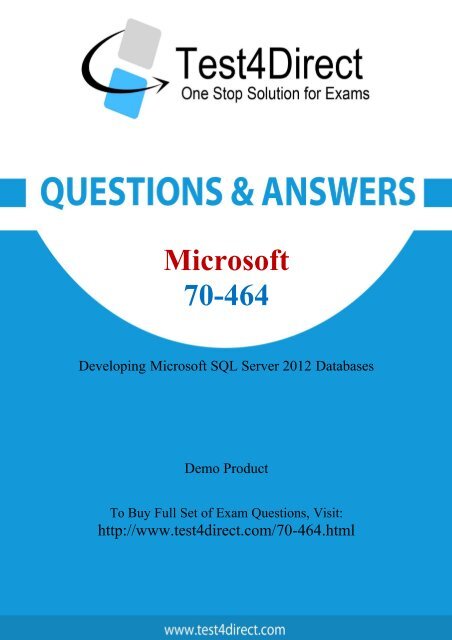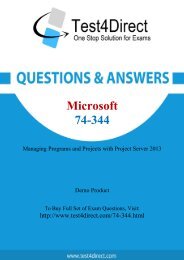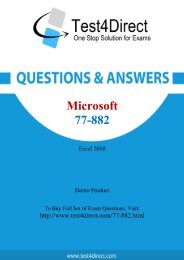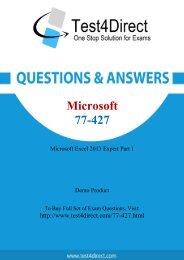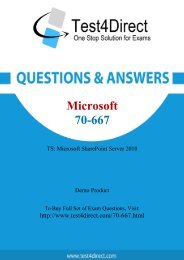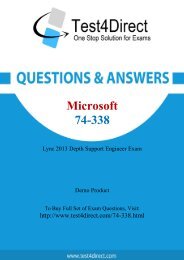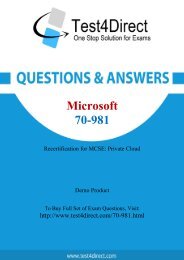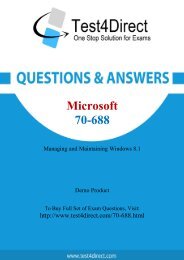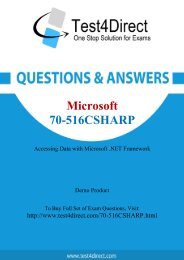Download 70-464 BrainDumps to Success in career
Test4Direct provides latest PDF questions of Microsoft 70-464 exam. You have an opportunity to pass the Microsoft 70-464 exam in one go. Test4Direct is most accurate source to prepare Microsoft 70-464 exam as your success will become site’s responsibility after purchasing 70-464 exam product. There are also lots of discounts and promotion offers that you can avail. Let’s try a free demo http://www.test4direct.com/70-464.html
Test4Direct provides latest PDF questions of Microsoft 70-464 exam. You have an opportunity to pass the Microsoft 70-464 exam in one go. Test4Direct is most accurate source to prepare Microsoft 70-464 exam as your success will become site’s responsibility after purchasing 70-464 exam product. There are also lots of discounts and promotion offers that you can avail. Let’s try a free demo http://www.test4direct.com/70-464.html
You also want an ePaper? Increase the reach of your titles
YUMPU automatically turns print PDFs into web optimized ePapers that Google loves.
Microsoft<br />
<strong>70</strong>-<strong>464</strong><br />
Develop<strong>in</strong>g Microsoft SQL Server 2012 Databases<br />
Demo Product<br />
To Buy Full Set of Exam Questions, Visit:<br />
http://www.test4direct.com/<strong>70</strong>-<strong>464</strong>.html
Case Study: 1<br />
Scenario 1<br />
Application Information<br />
Your company receives <strong>in</strong>voices <strong>in</strong> XML format from cus<strong>to</strong>mers. Currently, the <strong>in</strong>voices are<br />
s<strong>to</strong>red as files and processed by a desk<strong>to</strong>p application. The application has several<br />
performance and security issues. The application is be<strong>in</strong>g migrated <strong>to</strong> a SQL Server-based<br />
solution. A schema named InvoiceSchema has been created for the <strong>in</strong>voices xml.<br />
The data <strong>in</strong> the <strong>in</strong>voices is sometimes <strong>in</strong>complete. The <strong>in</strong>complete data must be s<strong>to</strong>red and<br />
processed as-is. Users cannot filter the data provided through views.<br />
You are design<strong>in</strong>g a SQL Server database named DB1 that will be used <strong>to</strong> receive, process,<br />
and securely s<strong>to</strong>re the <strong>in</strong>voice data. A third-party Microsoft .NET Framework component<br />
will be purchased <strong>to</strong> perform tax calculations. The third-party tax component will be<br />
provided as a DLL file named Treytax.dll and a source code file named Amortize.cs. The<br />
component will expose a class named TreyResearch and a method named Amortize(). The<br />
files are located <strong>in</strong> c:\temp\.<br />
The follow<strong>in</strong>g graphic shows the planned tables:<br />
You have a sequence named Account<strong>in</strong>g.InvoiceID_Seq.<br />
You plan <strong>to</strong> create two certificates named CERT1 and CERT2. You will create CERT1 <strong>in</strong><br />
master. You will create CERT2 <strong>in</strong> DB1.<br />
You have a legacy application that requires the ability <strong>to</strong> generate dynamic T-SQL statements<br />
aga<strong>in</strong>st DB1. A sample of the queries generated by the legacy application appears <strong>in</strong><br />
Legacy.sql.<br />
Application Requirements<br />
The planned database has the follow<strong>in</strong>g requirements:<br />
All s<strong>to</strong>red procedures must be signed.<br />
The orig<strong>in</strong>al XML <strong>in</strong>voices must be s<strong>to</strong>red <strong>in</strong> the database.<br />
An XML schema must be used <strong>to</strong> validate the <strong>in</strong>voice data.<br />
Dynamic T-SQL statements must be converted <strong>to</strong> s<strong>to</strong>red procedures.<br />
Access <strong>to</strong> the .NET Framework tax components must be available <strong>to</strong> T-SQL objects.<br />
Columns must be def<strong>in</strong>ed by us<strong>in</strong>g data types that m<strong>in</strong>imize the amount of space used<br />
by each table.
Invoices s<strong>to</strong>red <strong>in</strong> the InvoiceStatus table must refer <strong>to</strong> an <strong>in</strong>voice by the same<br />
identifier used by the Invoice table.<br />
To protect aga<strong>in</strong>st the theft of backup disks, <strong>in</strong>voice data must be protected by us<strong>in</strong>g<br />
the highest level of encryption.<br />
The solution must provide a table-valued function that provides users with the ability<br />
<strong>to</strong> filter <strong>in</strong>voices by cus<strong>to</strong>mer.<br />
Indexes must be optimized periodically based on their fragmentation by us<strong>in</strong>g the<br />
m<strong>in</strong>imum amount of adm<strong>in</strong>istrative effort.<br />
Usp_InsertInvoices.sql<br />
Invoices.xml<br />
All cus<strong>to</strong>mer IDs are 11 digits. The first three digits of a cus<strong>to</strong>mer ID represent the<br />
cus<strong>to</strong>mer's country. The rema<strong>in</strong><strong>in</strong>g eight digits are the cus<strong>to</strong>mer's account number.<br />
The follow<strong>in</strong>g is a sample of a cus<strong>to</strong>mer <strong>in</strong>voice <strong>in</strong> XML format:<br />
InvoicesByCus<strong>to</strong>mer.sql
Legacy.sql<br />
CountryFromID.sql<br />
IndexManagement.sql
Question: 1<br />
You are test<strong>in</strong>g disaster recovery procedures.<br />
You attempt <strong>to</strong> res<strong>to</strong>re DB1 <strong>to</strong> a different server and you receive the follow<strong>in</strong>g error message: "Msg<br />
33111.<br />
Level 16, State 3, L<strong>in</strong>e 1<br />
Cannot f<strong>in</strong>d server certificate with thumbpr<strong>in</strong>t<br />
,0xA694FBEA88C9354E5E2567C30A2A69E8FB4C44A9\<br />
Msg 3013, Level 16, State 1, L<strong>in</strong>e 1<br />
RESTORE DATABASE is term<strong>in</strong>at<strong>in</strong>g abnormally."<br />
You need <strong>to</strong> ensure that you can res<strong>to</strong>re DB1 <strong>to</strong> a different server.<br />
Which code segment should you execute?<br />
A. Option A<br />
B. Option B<br />
C. Option C<br />
D. Option D<br />
Question: 2<br />
You need <strong>to</strong> create the InvoiceStatus table <strong>in</strong> DB1.<br />
How should you def<strong>in</strong>e the InvoiceID column <strong>in</strong> the CREATE TABLE statement?<br />
Answer: B
A. Option A<br />
B. Option B<br />
C. Option C<br />
D. Option D<br />
Answer: C<br />
Question: 3<br />
Which data type should you use for Cus<strong>to</strong>merID?<br />
A. varchar(11)<br />
B. big<strong>in</strong>t<br />
C. nvarchar(11)<br />
D. char(11)<br />
Question: 4<br />
Answer: D<br />
Explanation:<br />
Invoices.xml<br />
All cus<strong>to</strong>mer IDs are 11 digits. The first three digits of a cus<strong>to</strong>mer ID represent the cus<strong>to</strong>mer'scountry.<br />
The rema<strong>in</strong><strong>in</strong>g eight digits are the cus<strong>to</strong>mer's account number.<br />
<strong>in</strong>t: -2^31 (-2,147,483,648) <strong>to</strong> 2^31-1 (2,147,483,647) (just 10 digits max)<br />
big<strong>in</strong>t: -2^63 (-9,223,372,036,854,775,808) <strong>to</strong> 2^63-1 (9,223,372,036,854,775,807)<br />
http://msdn.microsoft.com/en-us/library/ms176089.aspx<br />
http://msdn.microsoft.com/en-us/library/ms187745.aspx<br />
You need <strong>to</strong> modify InsertInvoice <strong>to</strong> comply with the application requirements.<br />
Which code segment should you execute?
A. Option A<br />
B. Option B<br />
C. Option C<br />
D. Option D<br />
Answer: D<br />
Question: 5<br />
You attempt <strong>to</strong> process an <strong>in</strong>voice by us<strong>in</strong>g usp_InsertInvoice.sql and you receive the follow<strong>in</strong>g error<br />
message: "Msg 515, Level 16, State 2, Procedure usp_InsertInvoice, L<strong>in</strong>e 10<br />
Cannot <strong>in</strong>sert the value NULL <strong>in</strong><strong>to</strong> column 'InvoiceDate', table 'DB1.Account<strong>in</strong>g.Invoices'; column<br />
does not allow nulls. INSERT fails."<br />
You need <strong>to</strong> modify usp_InsertInvoice.sql <strong>to</strong> resolve the error.<br />
How should you modify the INSERT statement?<br />
A. InvoiceDatevarchar(l00) 'InvoiceDate',<br />
B. InvoiceDatevarchar(100) 'Cus<strong>to</strong>mer/InvoiceDate', '<br />
C. InvoiceDate date '@InvoiceDate',<br />
D. InvoiceDate date 'Cus<strong>to</strong>mer/@InvoiceDate',<br />
Question: 6<br />
Question: 7<br />
Answer: B<br />
You need <strong>to</strong> modify the function <strong>in</strong> CountryFromID.sql <strong>to</strong> ensure that the country name is returned<br />
<strong>in</strong>stead of the country ID.<br />
Which l<strong>in</strong>e of code should you modify <strong>in</strong> CountryFromID.sql?<br />
A. 04<br />
B. 05<br />
C. 06<br />
D. 19<br />
Explanation:<br />
http://msdn.microsoft.com/en-us/library/ms186755.aspx<br />
http://msdn.microsoft.com/en-us/library/ms191320.aspx<br />
Answer: D<br />
You execute IndexManagement.sql and you receive the follow<strong>in</strong>g error message:<br />
"Msg 512, Level 16, State 1, L<strong>in</strong>e 12<br />
Subquery returned more than 1 value. This is not permitted when the subquery follows =,! =, = or when the subquery is used as an expression."<br />
You need <strong>to</strong> ensure that IndexManagement.sql executes properly.<br />
Which WHILE statement should you use at l<strong>in</strong>e 18?
A. WHILE SUM(@RowNumber) < (SELECT @counter FROM @<strong>in</strong>dextable)<br />
B. WHILE @counter < (SELECT COUNT(RowNumber) FROM @<strong>in</strong>dextable)<br />
C. WHILE COUNT(@RowNumber) < (SELECT @counter FROM @<strong>in</strong>dextable)<br />
D. WHILE @counter < (SELECT SUM(RowNumber) FROM 6<strong>in</strong>dextabie)<br />
Answer: B<br />
Question: 8<br />
You need <strong>to</strong> prepare the database <strong>to</strong> use the .NET Framework ProcessProducts component.<br />
Which code segments should you execute? (Each correct answer presents part of the solution.<br />
Choose all that apply.)<br />
A. Option A<br />
B. Option B<br />
C. Option C<br />
D. Option D<br />
E. Option E<br />
F. Option F<br />
G. Option G<br />
Explanation:<br />
http://msdn.microsoft.com/en-us/library/ms131048.aspx<br />
http://msdn.microsoft.com/en-us/library/ms131052.aspx<br />
http://msdn.microsoft.com/en-us/library/ms189524.aspx<br />
http://msdn.microsoft.com/en-us/library/ms345106.aspx<br />
http://msdn.microsoft.com/en-us/library/ms131107.aspx<br />
Question: 9<br />
Answer: A, B, D, E
You need <strong>to</strong> convert the functionality of Legacy.sql <strong>to</strong> use a s<strong>to</strong>red procedure.<br />
Which code segment should the s<strong>to</strong>red procedure conta<strong>in</strong>?<br />
A. Option A<br />
B. Option B<br />
C. Option C<br />
D. Option D<br />
Answer: D<br />
Explanation:<br />
http://msdn.microsoft.com/en-us/library/ms187926.aspx<br />
http://msdn.microsoft.com/en-us/library/ms190782.aspx<br />
http://msdn.microsoft.com/en-us/library/bb669091.aspx<br />
http://msdn.microsoft.com/en-us/library/w<strong>in</strong>dows/desk<strong>to</strong>p/ms<strong>70</strong>9342.aspx<br />
http://msdn.microsoft.com/en-us/library/ms188001.aspx<br />
Question: 10<br />
You need <strong>to</strong> create a function that filters <strong>in</strong>voices by Cus<strong>to</strong>merID. The SELECT statement for the<br />
function is conta<strong>in</strong>ed <strong>in</strong> InvoicesByCus<strong>to</strong>mer.sql.<br />
Which code segment should you use <strong>to</strong> complete the function?
A. Option A<br />
B. Option B<br />
C. Option C<br />
D. Option D<br />
Answer: A<br />
Question: 11<br />
DRAG DROP<br />
You need <strong>to</strong> build a s<strong>to</strong>red procedure that amortizes the <strong>in</strong>voice amount. Which code segmentshould<br />
you use <strong>to</strong> create the s<strong>to</strong>red procedure? To answer, move the appropriate code segmentsfrom the list<br />
of code segments <strong>to</strong> the answer area and arrange them <strong>in</strong> the correct order.<br />
Answer:<br />
Explanation:
http://msdn.microsoft.com/en-us/library/ms131089.aspx<br />
http://msdn.microsoft.com/en-us/library/ms131048.aspx<br />
http://msdn.microsoft.com/en-us/library/ms187926.aspx
THANKS FOR TRYING THE DEMO OF OUR PRODUCT<br />
Visit Our Site <strong>to</strong> Purchase the Full Set of Actual <strong>70</strong>-<strong>464</strong> Exam Questions With Answers.<br />
http://www.test4direct.com/<strong>70</strong>-<strong>464</strong>.html<br />
We Also Provide Practice Exam Software That Simulates Real Exam Environment And Has<br />
Many Self-Assessment Features. <strong>Download</strong> Free Product Demo From:<br />
http://www.test4direct.com/<strong>70</strong>-<strong>464</strong>.html<br />
Money Back Guarantee<br />
Check Out Our Cus<strong>to</strong>mer Testimonials


